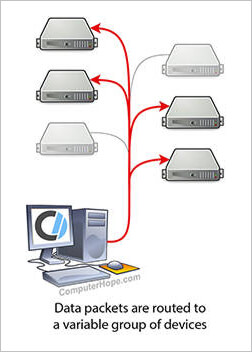Multicast

Multicast is a method of routing data on a computer network that allows one or more senders to communicate efficiently with a group of receivers.
Multicasting supports one-to-many routing, where a single device sends data to a group of devices. It also supports many-to-many routing, where a group sends data to a group.
Multicasting is one of the five major techniques for routing data on a computer network. The others are unicast, broadcast, anycast, and geocast.
Multicasting is more efficient than broadcasting because it can target specific devices, rather than an entire network segment. It reduces unnecessary network and processor resource usage.
Multicasting methods
In IP multicasting, devices use IGMP (Internet Group Management Protocol) messages to join or leave a multicast group. Any data packets sent to the multicast address for that group are distributed by the network hardware to all members of the group.
An alternative to IP (Internet Protocol) multicasting is application layer multicasting, where software performs multicasting using its own methods, regardless of support at the hardware level.
